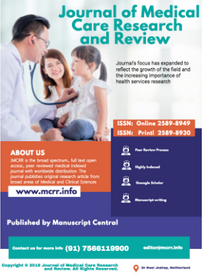Effects of high iodine containing low osmolar contrast agent (visipaque) on thyroid function tests
Abstract
Objective: Investigating high iodine containing low osmolar contrast agent (visipaque) effects on thyroid function tests and thyroid sonography characteristics.
Methods: 65 euthyroid cases and 92 controls composed the samples in baseline. Thyroid function tests, Urine Iodine Concentration (UIC) and thyroid sonography were conducted for both groups before and 1 and 3 months after angiography. Serum levels of T4,T3,T3RU,TSH,TPO-Ab and UIC were measured, and hypo/heyperthyroidism prevalence was compared between groups.
Results: Mean T3,T4 and TSH changes 1 month after angiography were insignificant in both groups (P:0.61,P:0.4 and P:0.14, P:0.23 in cases and controls for T3 and T4). Medians among cases and controls were 12.8 and 16.75 µg/dl, respectively, at baseline. These values varied to 28.45 and 15.2µg/dl, and 12.95 and 14.2µg/dl 1 month and 3 months after angiography in case and control groups, respectively. UIC increase one month after angiography was significant among cases (P=0.002). TPO-Ab+ were same 3 months after angiography. Thyroid volume changes were significant among cases (P<0.001) and insignificant among controls (P=0.680). No significant difference was seen between cases and controls in overt hypothyroidism, however, a considerable change was seen in thyroid volume and UIC one month after angiography among cases. The hypothyroidism rate among cases was insignificant which may be either related to few cases or short half-life of visipaque (2.1 hour) so that 97% of injected dose was excreted in urine within 24 hours.
Conclusion: Thyroid function test is not recommended before angiography in patients without previous thyroid records.
Full text article
References
2.Canaris GJ, Manowitz NR, Mayor G, Ridgway EC. The Colorado thyroid disease prevalence study. Archives of internal medicine. 2000;160(4):526-34.
3.Cappola AR, Fried LP, Arnold AM, Danese MD, Kuller LH, Burke GL, et al. Thyroid status, cardiovascular risk, and mortality in older adults. Jama. 2006;295(9):1033-41.
4.Koroscil M, PhD, Thomas M, Pelletier M, Peter R, Slauson M, James W, Hennessey M, James. Short-term effects of coronary angiographic contrast agents on thyroid function. Endocrine Practice. 1997;3(4):219-21.
5.Thomsen HS, Faber J. Iodine-based contrast media cause hyperthyroidism–another important adverse reaction to contrast media? : SAGE Publications; 2012.
6.Seminara M, Stephanie B, Daniels M, FACE, Gilbert H. Amiodarone and the thyroid. Endocrine Practice. 1998;4(1):48-57.
7.Hoang T, Mai V, Clyde P, Shakir M. Over-the-counter-drug-induced thyroid disorders. Endocrine Practice. 2013;19(2):268-74.
8.Toprak O, Cirit M, Bayata S, Yeşil M. Review of the radiocontrast nephropathy risk profiles and risk stratification. Anadolu kardiyoloji dergisi: AKD= the Anatolian journal of cardiology. 2004;4(4):331-5.
9.Katzberg R, Haller C. Contrast-induced nephrotoxicity: clinical landscape. Kidney International. 2006;69:S3-S7.
10.Eng PH, Cardona GR, Fang S-L, Previti M, Alex S, Carrasco N, et al. Escape from the acute Wolff-Chaikoff effect is associated with a decrease in thyroid sodium/iodide symporter messenger ribonucleic acid and protein. Endocrinology. 1999;140(8):3404-10.
11.Zimmermann MB, Aeberli I, Torresani T, Bürgi H. Increasing the iodine concentration in the Swiss iodized salt program markedly improved iodine status in pregnant women and children: a 5-y prospective national study. The American journal of clinical nutrition. 2005;82(2):388-92.
12.Lee SY, Rhee CM, Leung AM, Braverman LE, Brent GA, Pearce EN. A review: Radiographic iodinated contrast media-induced thyroid dysfunction. The Journal of Clinical Endocrinology & Metabolism. 2015;100(2):376-83.
13.Mann DL, Felker GM. Heart Failure E-Book: A Companion to Braunwald's Heart Disease: Elsevier Health Sciences; 2014.
14.Kornelius E, Chiou J-Y, Yang Y-S, Peng C-H, Lai Y-R, Huang C-N. Iodinated contrast media increased the risk of thyroid dysfunction: A 6-year retrospective cohort study. The Journal of Clinical Endocrinology & Metabolism. 2015;100(9):3372-9.
15.Alkhuja S, Pyram R, Odeyemi O. In the eye of the storm: Iodinated contrast medium induced thyroid storm presenting as cardiopulmonary arrest. Heart & Lung: The Journal of Acute and Critical Care. 2013;42(4):267-9.
16.Azizi F, Hatami H, Janghorbani M. Epidemiology and control of common diseases in Iran. Tehran: Eshtiagh Publications. 2000:602-16.
17.Marraccini P, Bianchi M, Bottoni A, Mazzarisi A, Coceani M, Molinaro S, et al. Prevalence of thyroid dysfunction and effect of contrast medium on thyroid metabolism in cardiac patients undergoing coronary angiography. Acta Radiologica. 2013;54(1):42-7.
18.Ozkan S, Oysu AS, Kayatas K, Demirtunç R, Eren M, Uslu H, et al. Thyroid functions after contrast agent administration for coronary angiography: a prospective observational study in euthyroid patients. Anadolu Kardiyol Derg. 2013;13(4):363-9.
19.Egorov V, Sviridenko N, Platonova N, Arbuzova M, Zlotnikova O, Buziashvili I, et al. Disturbances of thyroid function after coronary angiography. Kardiologiia. 2005;46(4):46-9.
20.van der Molen AJ, Thomsen HS, Morcos SK, Radiology MoCMSCoESoU. Effect of iodinated contrast media on thyroid function in adults. European radiology. 2004;14(5):902-7.

